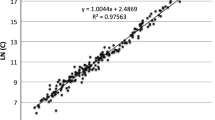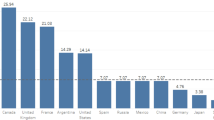Abstract
How to effectively make an international comparison of the basic research capacity in a specific field is an urgent problem for a country to monitor the science and technology activities. In this paper, we develop a composite index, that is, Basic Research Competitiveness Index (BR-CI), for evaluating the countries’ basic research performance versus the world average level over time. For this purpose, the three sub-indexes, namely, Activity Index (AcI), Attractive Index (AtI) and Efficiency Index (EI), are proposed, which are respectively used to assess the countries’ research efforts, impacts, efficiency versus the world average level in a particular science field over time. The proposed indicator system can present the cross-time and cross-country comparison of research performance, which can quantify the basic research competiveness relative to the world average level, and describe the competitive landscape among countries in the world. As the first application, this paper employs the four indicators, AcI, AtI, EI and BR-CI, to measure and compare the five leading countries’ research performances in the biomass energy field. In short, the modelling and empirical study in this paper not only offers some new references for fully exploring the international competition in the basic research of biomass energy field, but also provides some new perspectives and ideas for examining the international competitiveness in the basic research field of science and technology.








Similar content being viewed by others
Notes
Schwab (2010) is World Economic Forum Editor. We mainly adopt the research ideas of Joint Research Centre of the European Commission (JRC) that creating the Global Competitiveness Index contained in The Global Competitiveness Report of the World Economic Forum.
To verify whether this order of countries follows the trend of publishing in other fields or is unique to the biomass energy field, we respectively search for all the publishing indexed in SCI database and in one specific field: energy storage. After making some research and analysis, we find that the order of five leading countries is USA, China, Germany, UK and Japan in the SCI database. Besides, we find that the order of countries in research field of energy storage is USA, China, South Korea, Germany and Japan. Thus we can conclude that the order of countries presented in our paper is unique to the biomass energy field although USA, China and Japan are always the major contributors in many fields.
References
Abdullah, N., Roffeei, S. H. M., Kamarulzaman, Y., Yusop, F. D., Madun, A., & Ng, K. H. (2015). Evaluating the performance of electromagnetic fields (EMF) research work (2003–2013). Scientometrics, 105(1), 261–278.
Abramo, G., D’Angelo, C. A., & Di Costa, F. (2011). Research productivity: Are higher academic ranks more productive than lower ones? Scientometrics, 88(3), 915–928.
Aksnes, D. W., van Leeuwen, T. N., & Sivertsen, G. (2014). The effect of booming countries on changes in the relative specialization index (RSI) on country level. Scientometrics, 101(2), 1391–1401.
Chen, K., & Guan, J. (2011). A bibliometric investigation of research performance in emerging nanobiopharmaceuticals. Journal of Informetrics, 5(2), 233–247.
Chen, D. Z., Lin, W. Y. C., & Huang, M. H. (2007). Using essential patent index and essential technological strength to evaluate industrial technological innovation competitiveness. Scientometrics, 71(1), 101–116.
Cohen, W. M., Nelson, R. R., & Walsh, J. P. (2002). Links and impacts: The influence of public research on industrial R&D. Management Science, 48(1), 1–23.
Corma, A., Iborra, S., & Velty, A. (2007). Chemical routes for the transformation of biomass into chemicals. Chemical Reviews, 107(6), 2411–2502.
Cortright, R. D., Davda, R. R., & Dumesic, J. A. (2002). Hydrogen from catalytic reforming of biomass-derived hydrocarbons in liquid water. Nature, 418(6901), 964–967.
Dajun, Y., Fengqi, Y., & Snyder, S. W. (2014). Biomass-to-bioenergy and biofuel supply chain optimization: Overview, key issues and challenges. Computers & Chemical Engineering, 66, 36–56.
Delbari, S. A., Ng, S. I., Aziz, Y. A., & Ho, J. A. (2015). Measuring the influence and impact of competitiveness research: A Web of Science approach. Scientometrics, 105(2), 773–788.
Diem, A., & Wolter, S. C. (2012). The use of bibliometrics to measure research performance in education sciences. Research in Higher Education, 54(1), 86–114.
Dincer, K. (2008). Lower emissions from biodiesel combustion. Energy Sources Part A Recovery Utilization and Environmental Effects, 30(10), 963–968.
Ding, Z. Q., Ge, J. P., Wu, X. M., & Zheng, X. N. (2013). Bibliometrics evaluation of research performance in pharmacology/pharmacy: China relative to ten representative countries. Scientometrics, 96(3), 829–844.
Fang, Y., Zhu, D., & Zheng, Y. (2015). The current status and systematic framework of talent programmes in basic research in China: A system theory perspective. Technology Analysis & Strategic Management, 27(6), 722–738.
Frame, J. D. (1977). Mainstream research in Latin America and Caribbean. Interciencia, 2(2), 143–148.
Garg, K. C. (2002). Scientometrics of laser research in India and China. Scientometrics, 55(1), 71–85.
Guan, J. C., & He, Y. (2005). Comparison and evaluation of domestic and international outputs in Information Science & Technology research of China. Scientometrics, 65(2), 215–244.
Guan, J., & Ma, N. (2004). A comparative study of research performance in computer science. Scientometrics, 61(3), 339–359.
Guan, J., & Ma, N. (2007a). A bibliometric study of China’s semiconductor literature compared with other major asian countries. Scientometrics, 70(1), 107–124.
Guan, J., & Ma, N. (2007b). China’s emerging presence in nanoscience and nanotechnology—A comparative bibliometric study of several nanoscience ‘giants’. Research Policy, 36(6), 880–886.
Gzoyan, E. G., Hovhannisyan, L. A., Aleksanyan, S. A., Ghazaryan, N. A., Hunanyan, S. R., Bourghida, A., & Sargsyan, S. A. (2015). Comparative analysis of the scientific output of Armenia, Azerbaijan and Georgia. Scientometrics, 102(1), 195–212.
Hu, X., & Rousseau, R. (2009). A comparative study of the difference in research performance in biomedical fields among selected Western and Asian countries. Scientometrics, 81(2), 475–491.
Huber, G. W., Iborra, S., & Corma, A. (2006). Synthesis of transportation fuels from biomass: Chemistry, catalysts, and engineering. Chemical Reviews, 106(9), 4044–4098.
Kajikawa, Y., & Takeda, Y. (2008). Structure of research on biomass and bio-fuels: A citation-based approach. Technological Forecasting and Social Change, 75(9), 1349–1359.
Konur, O. (2011). The scientometric evaluation of the research on the algae and bio-energy. Applied Energy, 88(10), 3532–3540.
Konur, O. (2012). The scientometric evaluation of the research on the production of bioenergy from biomass. Biomass and Bioenergy, 47, 504–515.
Kostoff, R. N. (2012). China/USA nanotechnology research output comparison—2011 update. Technological Forecasting and Social Change, 79(5), 986–990.
Lenoir, T., & Herron, P. (2009). Tracking the current rise of Chinese pharmaceutical bionanotechnology. Journal of Biomedical Discovery and Collaboration, 4(8). http://pear.accc.uic.edu/ojs/index.php/jbdc/article/viewArticle/2491.
Li, F., Yi, Y., Guo, X., & Qi, W. (2012). Performance evaluation of research universities in Mainland China, Hong Kong and Taiwan: Based on a two-dimensional approach. Scientometrics, 90(2), 531–542.
Liu, W. S., Gu, M. D., Hu, G. Y., Li, C., Liao, H. C., Tang, L., & Shapira, P. (2014). Profile of developments in biomass-based bioenergy research: A 20-year perspective. Scientometrics, 99(2), 507–521.
Martin, B. R. (1996). The use of multiple indicators in the assessment of basic research. Scientometrics, 36(3), 343–362.
Meng, W., Hu, Z., & Liu, W. (2006). Efficiency evaluation of basic research in China. Scientometrics, 69(1), 85–101.
Moed, H. F. (2002). Measuring China’s research performance using the Science Citation Index. Scientometrics, 53(3), 281–296.
Narin, F., Hamilton, K. S., & Olivastro, D. (1997). The increasing linkage between U.S. technology and public science. Research Policy, 26(3), 317–330.
OECD. (1997). National innovation systems. Paris: Organisation for Economic Co-operation and Development, France.
Porter, M., & Stern, S. (1999). The new challenge to America’s prosperity: Findings from the innovation index (P. 96). USA: Council on Competitiveness Publications Office.
Price, D. (1965). Networks of scientific papers. Science, 149(3683), 510–515.
Radicchi, F., & Castellano, C. (2012). Testing the fairness of citation indicators for comparison across scientific domains: The case of fractional citation counts. Journal of Informetrics, 6(1), 121–130.
Saisana, M., d’Hombres, B., & Saltelli, A. (2011). Rickety numbers: Volatility of university rankings and policy implications. Research Policy, 40(1), 165–177.
Saxena, R. C., Adhikari, D. K., & Goyal, H. B. (2009). Biomass-based energy fuel through biochemical routes: A review. Renewable and Sustainable Energy Reviews, 13(1), 167–178.
Schubert, A., & Braun, T. (1986). Relative indicators and relational charts for comparative assessment of publication output and citation impact. Scientometrics, 9(5–6), 281–291.
Schwab, K. (2010). The global competitiveness report 2010–2011. Geneva, Switzerland.
Tang, L., & Shapira, P. (2011). Regional development and interregional collaboration in the growth of nanotechnology research in China. Scientometrics, 86(2), 299–315.
Toole, A. A. (2012). The impact of public basic research on industrial innovation: Evidence from the pharmaceutical industry. Research Policy, 41(1), 1–12.
Tuck, C. O., Perez, E., Horvath, I. T., Sheldon, R. A., & Poliakoff, M. (2012). Valorization of biomass: Deriving more value from waste. Science, 337(6095), 695–699.
Wang, L. (2016). The structure and comparative advantages of China’s scientific research: Quantitative and qualitative perspectives. Scientometrics, 106(1), 435–452.
Zhou, P., & Leydesdorff, L. (2006). The emergence of China as a leading nation in science. Research Policy, 35(1), 83–104.
Zhu, J., Hassan, S. U., Mirza, H. T., & Xie, Q. (2014). Measuring recent research performance for Chinese universities using bibliometric methods. Scientometrics, 101(1), 429–443.
Acknowledgments
The work in this paper was jointly funded by the National Natural Science Foundation of China (Project Number 71471170; 71103173; 71373254; 71233003), the Major Research Task of Institute of Policy and Management in Chinese Academy of Sciences (Project Number Y201121Z01), the Key Projects of Philosophy and Social Sciences Research, Ministry of Education of China (Project Number 12JZD042), the Key Natural Science Foundation of Guangdong Province in China (Project Number S2013020012767) and the Major Research Task of Advisory Institute for Scientific Strategies in Chinese Academy of Sciences (Project Number Y501141S01).
Author information
Authors and Affiliations
Corresponding author
Appendices
Appendix 1
The comparison of citations of research outputs by considering the 2- and 5-year lags, respectively (Fig. 9).
The biomass energy citations of five leading countries by considering the 2- and 5-year lags, respectively. a The number of citations by considering 2-year lags (2005–2012), b the number of citations by considering 5-year lags (2005–2009), c the world share of citations by considering 2-year lags (2005–2012), d the world share of citations by considering 5-year lags (2005–2009)
Appendix 2
The comparison of Attractive Index (AtI) of major countries by considering the 2- and 5-year lags, respectively (Fig. 10).
Appendix 3
The comparison of Efficiency Index (EI) of major countries by considering the 2- and 5-year lags, respectively (Fig. 11).
Appendix 4
The comparison of Basic Research Competitiveness Index (BR-CI) of major countries by considering the 2- and 5-year lags, respectively (Figs. 12, 13).
Rights and permissions
About this article
Cite this article
Zhang, Y., Kou, M., Chen, K. et al. Modelling the Basic Research Competitiveness Index (BR-CI) with an application to the biomass energy field. Scientometrics 108, 1221–1241 (2016). https://doi.org/10.1007/s11192-016-2042-y
Received:
Published:
Issue Date:
DOI: https://doi.org/10.1007/s11192-016-2042-y









